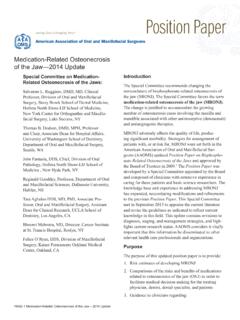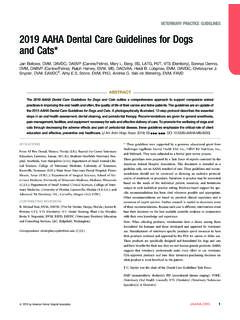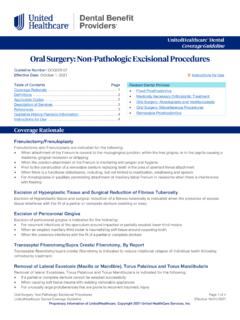Transcription of Pathologic conditions of the maxillary sinus
1 Editor:Allan G. Farman, BDS, PhD(odont.), DSc (odont.),Diplomate of theAmerican Board of Oraland MaxillofacialRadiology, Professor ofRadiology and ImagingSciences, Department ofSurgical and HospitalDentistry, The University ofLouisville School ofDentistry, Louisville, :Dr. Nortj , BChD, PhD, DSc,Professor and Chairman ofOral and MaxillofacialRadiology, Tygerberg, SouthAfrica, President-Elect of theInternational Association ofDentomaxillofacial Article: Pathologic conditions ofthe maxillary sinusIn The Recent Literature: oral CancerMaxillofacial TraumaVolume 2, Issue 3US $ of the maxillarysinuses is often undertaken usingcomputed tomography, magneticresonance imaging, or theoccipito-mental plain x-ray filmprojection. However the panoramicradiograph has been foundsuperior to the latter for detectionof cyst-like densities.
2 [1]. Theoccipito-mental technique, firstdescribed by Waters and Waldron,clearly demonstrates the superior,inferior and lateral margins of themaxillary sinuses while reflectingthe shadows of the petroustemporal bones downwards belowthe inferior margin of the sinuses [2].It also demonstrates well any softtissue or fluid contents of the sinus [1]; however, this method does notdisplay the cortices of the anteriorand posterior CT, MRI and the Waters projection are well suited todemonstrate the maxillary sinuses,these methods are only employedif there are signs and symptoms ofdisease, by which time theprognosis for patients having suchinsidious disease as squamous-cellcarcinoma can be poor [3].Extensive lesions occupying themaxillary sinus can producesurprisingly few clinical features [4].For this reason, the panoramicradiograph can be the primaryindication of maxillary sinusdisease.
3 While panoramicradiography can be used todetect maxillary sinus disease, itcannot be used to entirely excludesinus pathology. Only the portionsof the sinus that are within theimage layer will be the panoramic image layer mostclosely reflects the dental arch, sinus disease occasionally ariseswithin the sinuses outside the of the maxillary sinusare comparatively frequent, even inapparently young individuals withrates in excess of one in fiveindividuals examined using theWaters projection (mucosalthickening ; cysts or ; opacified sinus ) [5]. Forthis reason, it is incumbent upon thedental practitioner to understandthe panoramic radiological featuresof disease and normal variationswithin the paranasal the patient should not bereferred to an ear, nose and throatspecialist for every instance ofantral mucosal thickening ormucous retention cyst (Fig.)
4 1 &2), norshould the dentist ignore featuresthat possibly reflect an earlymalignancy. The reputation of apractitioner is greatly enhancedgiven appropriate referrals that canmake the difference between lifeand death. Failure to diagnose, onthe other hand, can result et al [3] were among thefirst to comprehensively study theappearance on panoramic dentalradiographs of pathologicalconditions affecting the maxillarysinuses, comparing inflammatoryconditions of dental origin,iatrogenic disease/foreign bodies,non-odontogenic inflammatoryconditions, cysts, benignneoplasms, malignant neoplasmsand dysplasias affecting conditions of themaxillary sinusBy Dr. Allan G. Farman incollaboration with Dr. Nortj The early detection of insidious maxillary sinus diseasecan be very important for the patient prognosis,especially in the case of malignant neoplasia.
5 Chronic abscesses resulted in aloss of the outline of the lowerborder of the sinus where it abuttedthe associated tooth, and a relatedthickening of the sinus mucosa wasoccasionally evident. Radicularcysts (generally associated withthe root apex of a carious orfractured tooth) and residual cystscaused an upward displacementof the floor of the sinus , but thecortical outline remained dental cysts extendedinto the sinus away from the originalepicenter (Fig. 3). Even a very largeradicular cyst arising in the maxillaresulted in surprisingly little in theway of clinically noticeable jawexpansion. Dentigerous cysts had asimilar effect on the floor of themaxillary sinus to that observed forradicular cysts, however, thedentigerous cyst enveloped thecrown of an unerupted tooth. As thetooth was displaced there was theappearance of a tooth suspendedwithin the keratocysts arehomogeneous radiolucencies thatmight be unilocular, crenulated ormultilocular in outline, andoccasionally they envelopeunerupted teeth (Fig.)
6 4). These alsotend to displace the sinus floor andto extend into the sinus whileproducing little in the way of jawexpansion. Benign tumors in generaldisplaced the sinus floor andexpanded into the maxillary sinusrather than outwards (Fig. 5).Trabeculation within multiloculartumors such as the myxoma and theameloblastoma frequentlyobscured the maxillary sinus comparison with benignneoplasms, malignant tumorsaffecting the portion of the sinusscreened by the plane of thepanoramic radiograph resulted inirregular erosion of 1. Mucous retention cyst : detail frompanoramic radiograph showsdomed soft tissue density inleft maxillary sinus (arrow).Fig. 2. Mucous retentioncyst of maxillary sinus (arrow) shown using theoccipito-mental projection(Waters projection). Thisprojection can be madeusing the cephattachment available foruse with 3.
7 Radicular cyst on carious rightmaxillary lateral incisor. The lesion is awell-delineated unilocular homogeneousradiolucency. It has grown so large that ithas caused a displacement of theipsilateral anterior wall and floor of themaxillary malignancies affectingthe maxillary sinus includesquamous-cell carcinoma,adenoid cystic carcinoma andadenocarcinoma [7]. The maxillarysinus may also be affectedsecondarily by extensionmalignancies of the oral softtissues or jaw, and also, althoughrare, is the site of metastases fromdistant sites [8].Owing to their radio-opacity,roots or whole teeth displaced intothe sinus are readily apparent evenwhen not centered within theimage layer. These need to bedifferentiated from sinus bonenodules and antroliths (calcified stones arising in the antral lining)both of which entities could bemistaken for teeth or displacedroots [9].
8 Foreign bodies, such asbullets, are clearly demonstrated;however care needs to be made todifferentiate between clearlydemarcated real images, andblurred magnified ghost images offoreign bodies or jewelry moredistally and lower placed in or onthe contralateral side of the fistulas following dentalextraction are only noticeable onpanoramic radiography when large and within the panoramic inflammatoryconditions of non-odontogenicorigin, these are usually clearlydemonstrated on panoramicradiography if they involve mucosalthickenings arising from the floor ofthe maxillary sinus . The mostfrequent example of such aprocess is the mucous retentionphenomenon. This is seen as asmooth dome-shape swelling ofthe mucosa with homogeneousradiodensity. The sinus floor is notdisplaced or eroded. A mucousretention phenomenon is rarelyFig.
9 5. Benignneoplasm,adenomatoidodontogenic tumor:unilocular lesion in theleft maxilla subjacentto the canine tooth(cropped panoramic,occlusal andspecimenradiographs). Notedisplacement ofmaxillary sinus floor(arrow).Fig. 6. Fibrous dysplasia:cropped panoramic radiographshowing mature (late) lesion ofthe left maxilla, obscuring thesinus. The lesion is radio-opaque with some radiolucentmottling. It has a ground(frosted) glass lesion melds with thenormal surrounding 4. Odontogenic keratocyst: multiple lesions inboth jaws in nevoid basal cell carcinoma maxillary lesions are unilocular while themandibular lesions are crenulated and is displacement of enveloped teeth, someof which apparently float in the maxillary sinuses( arrows).symptomatic; it requires notreatment. Antral polyps are onlyclearly demonstrated whensituated in the panoramic imagelayer.
10 This is rarely the case;hence, other radiographic viewsare preferred. Opacified sinusesor fluid levels may be found withacute sinusitis, whichaccompanies the commoncold in of cases [5;6].The maxilla can also be thesite of a variety of dysplasticand fibro-osseous dysplasia can cause thepartial or complete occlusion ofthe sinus on the affected side ofthe maxilla (Fig. 6). This may arisein young children and is usuallyapparent by adolescence. It isgenerally unilateral. By way ofcomparison, Paget s disease ofbone can also cause occlusionof the sinus , but can affect bothsides of the maxilla and is foundin an aging population (Fig. 7).Cherubism may affect themaxillary tuberosities bilaterallyas well as the mandibular lesions are initiallymultilocular radiolucencies andlater Significance ofMaxillary sinus DiseaseThe early detection of insidiousmaxillary sinus disease can bevery important for the patient sprognosis, especially in the caseof malignant neoplasia.




